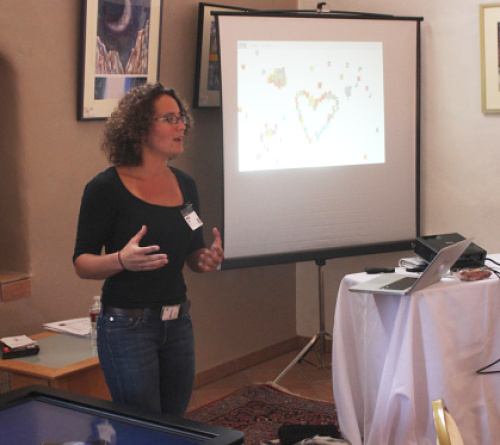Social Opportunities Around a Multitouch Table
 Nina Simon is founder of Museum 2.0, a consultancy that focuses on creating exhibits that promote social interaction. Nina strives to make exhibits and programs that encourage visitors to contribute to institutions and engage socially with each other.
Nina Simon is founder of Museum 2.0, a consultancy that focuses on creating exhibits that promote social interaction. Nina strives to make exhibits and programs that encourage visitors to contribute to institutions and engage socially with each other.
At the Open Exhibits Design Summit, she discussed the many barriers to engaging groups of strangers in museums, particularly in North America. Visitors typically interact within their own personal group(s). Therefore, you can’t assume that visitors will interact with strangers and it’s necessary to build opportunities for social interaction into the exhibit design.
How do you do this? Here are Nina’s suggestions:
DON’T ASSUME INTERACTION
One of the ways to build in interaction is to incorporate signs that sanction or give permission for people to talk to strangers at an exhibit. In past exhibits, Nina used signs like “Go up to someone your height and ask them to do this activity with you” or “Ask someone of the same gender to do this exhibit with you.”
“It’s important to put the onus of responsibility on the museum to facilitate these connections.” Nina sees the museum acting like a party host who introduces guests to each other.”
Jumping in Museums is a great example of a project that facilitates strangers coming together to participate in a fun experience.”
MAXIMIZE FLEXIBILITY, MINIMIZE DISRUPTION
In a museum exhibit, it is important to maximize flexibility and minimize disruption. People approach exhibits at different times and leave at their own pace. Exhibits cannot require that people start or end together and changes in engagement cannot stop or ruin the group’s experience.
So, how do we create shared activities that allow for personal flexibility, without disrupting the exhibit? For example: with multitouch tables, where users are manipulating objects in a shared environment, how do we minimize users’ ability to steal objects from other users or “ruin” other users play?
Creating exhibits that have a balance of personal space and shared space is one answer. Or is it? In a game like Just Letters users manipulate alphabet-shaped refrigerator magnets. Part of the fun of this game is that people are stealing each other’s letters. Proving there are ways to create fun experiences that utilize disruption by design.
TO PROMOTE SOCIAL INTERACTION, MAKE IT CORE TO THE DESIGN

Nina also described an advice wall in a museum where visitors would post questions like “What do you do for a hangover?” Other visitors write answers on post-its and stick them onto the board, and the sense of a large conversation was created.
“The exhibit was inherently social, effective at connecting strangers, and allowed people to interact on their own schedules and at their own pace; a hallmark of multiuser design.”
by Chad Person ![]() on March 11, 2011
on March 11, 2011